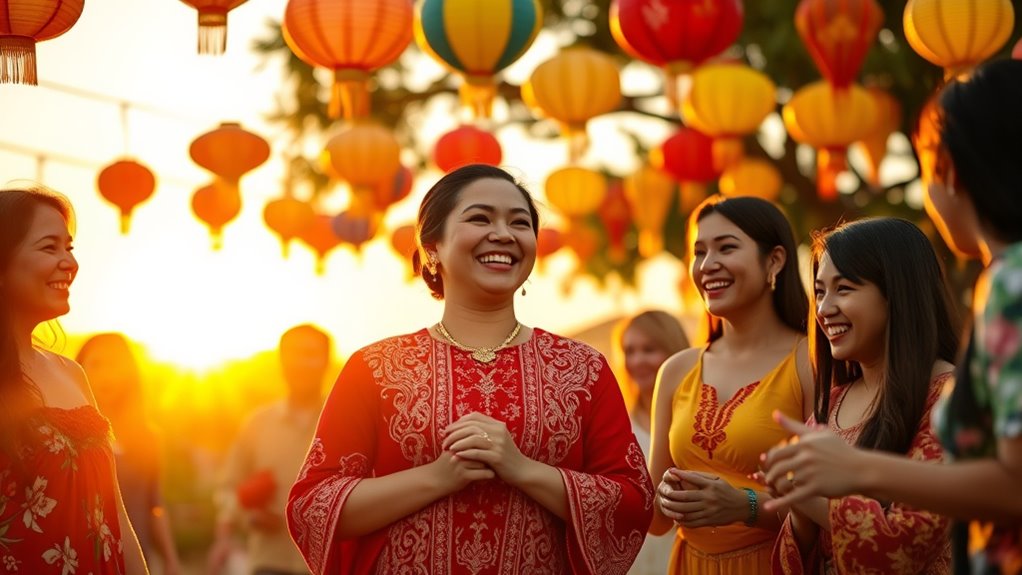A Filipina’s culture unites us through its rich tapestry of traditions, strong family bonds, and vibrant festivals. You’ll find that food builds connections during family gatherings, while music and arts foster community spirit. Respect and shared values guide our interactions, enhancing adaptability in diverse environments. Together, we celebrate cultural heritage and stories that echo across generations. Discover how these elements intertwine to create lasting connections and a sense of belonging that transcends time.
Key Takeaways
- The rich tapestry of Filipino culture fosters strong community ties through shared traditions and stories, creating lasting connections among diverse groups.
- Family gatherings centered around traditional food reinforce kinship, as sharing meals fosters joy and strengthens relationships across generations.
- Music and arts serve as powerful connectors, celebrating cultural heritage and uniting people through shared experiences during festivals.
- Respect for elders and strong values promote social harmony, enhancing relationships and adaptability within multicultural environments.
- Educational initiatives and welcoming networks ensure cultural stories endure, fostering cooperation and understanding among diverse communities.
The Rich Tapestry of Filipino Culture
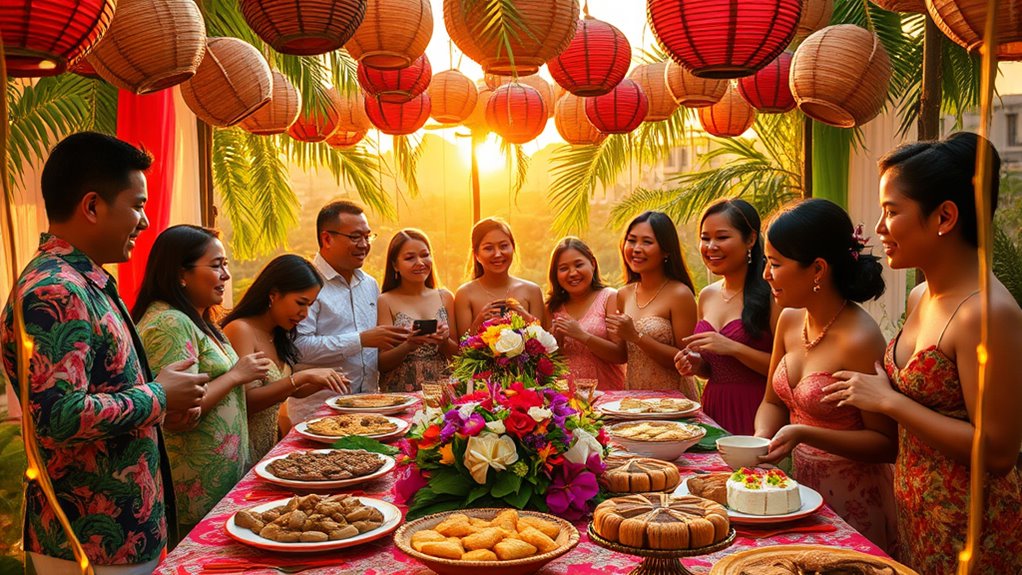
While you may think of Filipino culture as just a collection of traditions, it’s actually a vibrant tapestry woven from diverse historical influences and rich practices.
The indigenous Igorot and Ifugao tribes shaped community celebrations and terracing methods, while Malay settlers introduced rice cultivation, a staple in Filipino diets.
Chinese traders infused silk and porcelain into local customs, blending seamlessly with indigenous practices.
Spanish colonization brought Christianity and architectural beauty, while American influence transformed education and governance.
This cultural fusion manifests in lively festivals like Sinulog and MassKara, showcasing colorful masks and dances.
Traditional arts, from indigenous music to jeepney art, further reflect this unique blend, making Filipino culture a lively and dynamic expression of its history and values.
Family Bonds: The Heart of Filipino Life
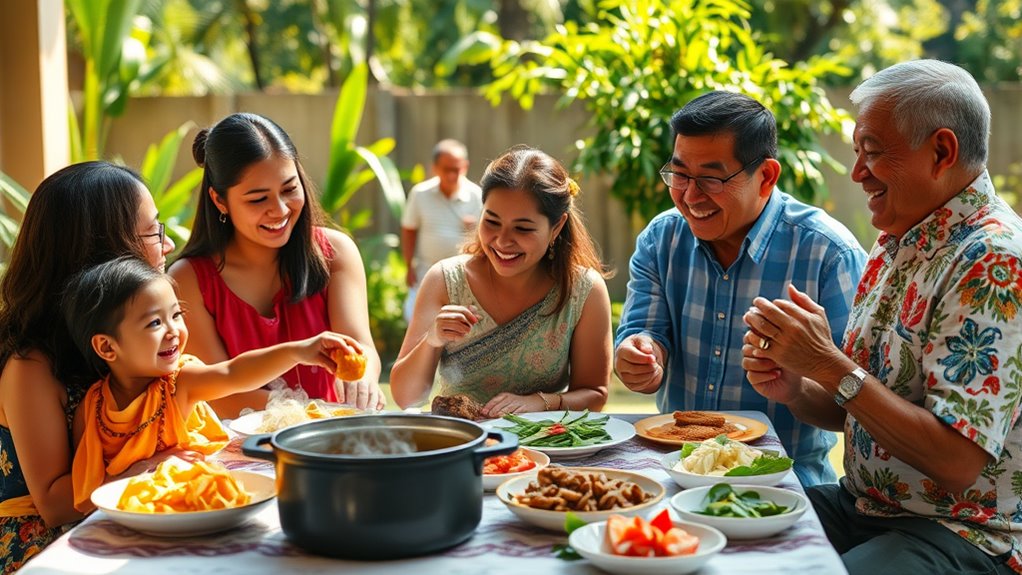
Family bonds are the essence of Filipino life, reflecting a deep-rooted commitment to kinship and community.
In many households, you’ll find multiple generations living together, which fosters a strong sense of shared responsibilities and communal living. While nuclear families are becoming more common due to modernization, extended family ties remain unbreakable. Emotional damage from strained relationships can significantly affect family unity and support systems. This interconnectedness can also be seen in the way families prioritize sleep solutions that cater to the needs of all members, ensuring everyone feels supported and cared for.
Elders are revered, offering wisdom and guidance that enriches family dynamics. You’ll often see grandparents actively involved in childcare and domestic duties, reinforcing interconnected roles within the family.
Family gatherings are essential for maintaining unity, as they provide opportunities to celebrate life events and strengthen bonds. Cacao’s health benefits include antioxidants and mood enhancement, which can also contribute to a sense of togetherness during family celebrations.
Despite the challenges posed by urbanization, family remains a significant source of emotional and financial support, highlighting the resilience and adaptability of Filipino families.
Celebrating Together: The Role of Festivals
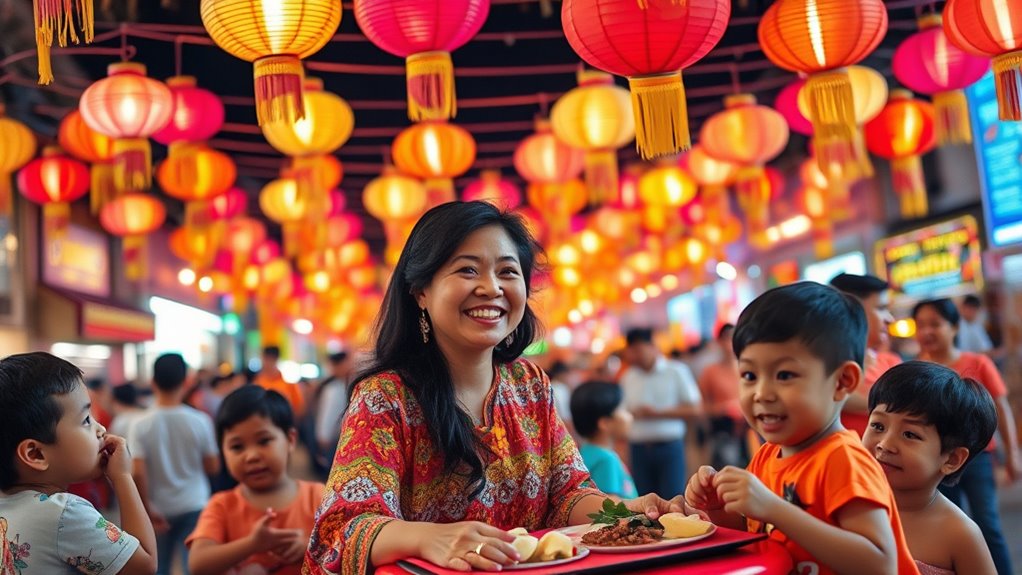
In the vibrant tapestry of Filipino culture, festivals play an essential role in bringing people together, much like the strong family bonds that define everyday life.
These celebrations preserve traditions and engage locals and tourists alike, showcasing the rich heritage shaped by diverse influences. You’ll find entire neighborhoods coming together to prepare for events centered around patron saints, reflecting the deep roots of Catholicism in the culture.
Celebrations unite communities, preserving traditions and highlighting the vibrant heritage shaped by diverse influences.
Community spirit thrives through street dancing, culinary contests, and communal feasting, where everyone shares their hospitality. Festivals like the Sinulog and Ati-Atihan attract millions, boosting local economies and promoting cultural heritage on a global scale.
Ultimately, these events foster unity, celebrate history, and create lasting memories for all involved.
Music and Arts: A Cultural Connection
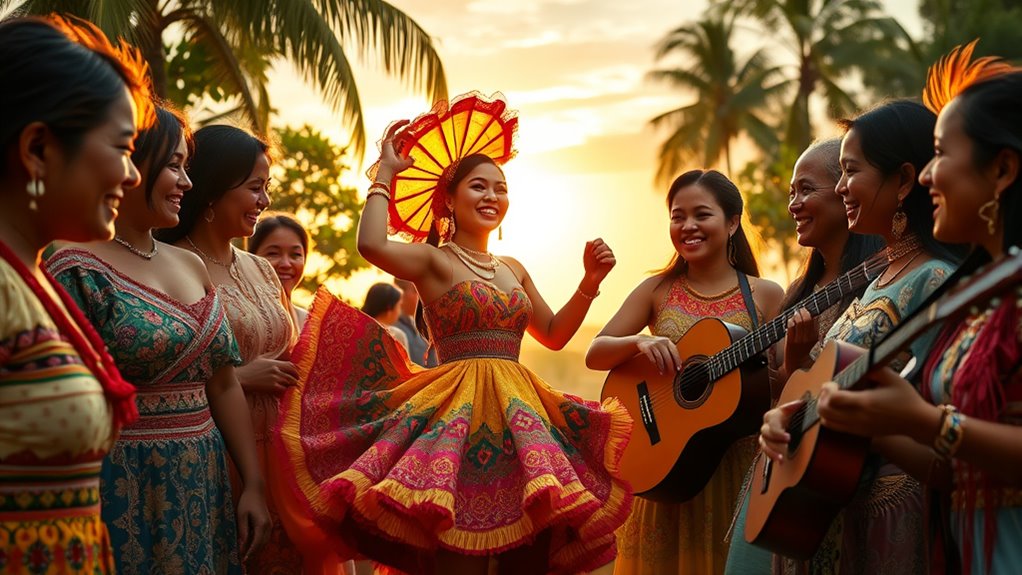
Music and arts serve as powerful connectors, weaving together the diverse threads of Filipino culture in ways that resonate deeply with individuals and communities alike.
Original Pilipino Music (OPM) acts as a cultural bridge, blending local traditions with Western influences. Emerging post-martial law, it reflects social commentary and ignites movements for change.
Traditional arts, on the other hand, showcase a rich tapestry of indigenous, Asian, and colonial influences, from textiles to wood carvings. Modern artists innovate these forms, engaging communities and preserving heritage.
Festivals amplify this connection, celebrating the dynamic evolution of music and art while fostering cultural exchange.
Ultimately, these creative expressions unite people, enriching shared experiences and strengthening cultural identity.
Religious Traditions and Their Influence
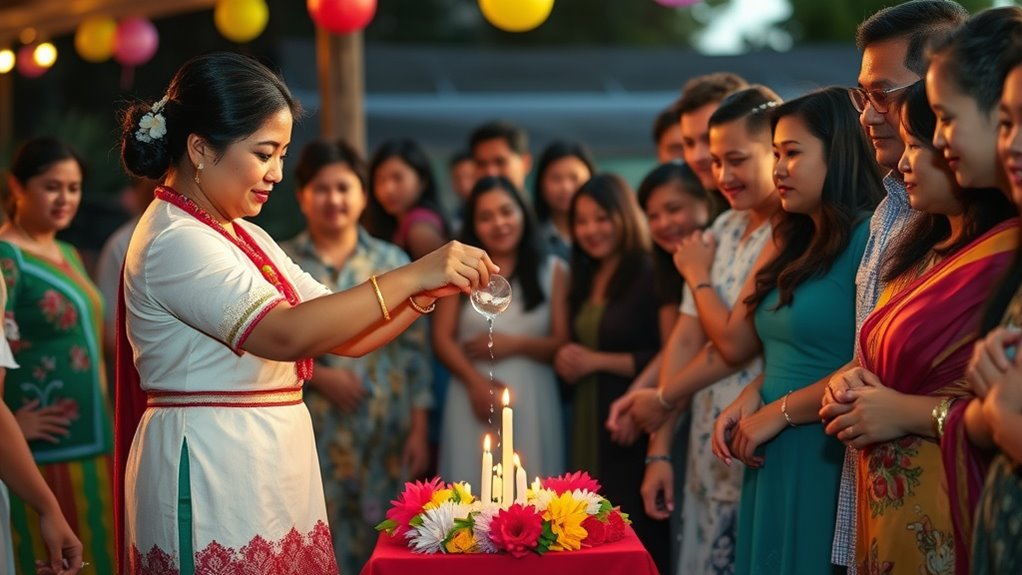
While exploring the rich tapestry of Filipino culture, you’ll find that religious traditions play an essential role in shaping the nation’s identity. Over 86% of Filipinos practice Roman Catholicism, making it the only Christian nation in Asia. This influence intertwines with indigenous beliefs, creating a unique spiritual landscape.
You’ll notice vibrant festivals that blend Catholic and indigenous elements, showcasing the community’s deep-rooted faith. Islam, primarily found in Mindanao, adds to this diversity, while Protestantism and indigenous practices also contribute.
Despite differing beliefs, Filipinos foster interfaith harmony, uniting through shared values and traditions. This rich religious tapestry not only defines the Filipino experience but also provides strength and resilience in times of challenge, illustrating the profound impact religion has on everyday life.
The Importance of Respect and Values
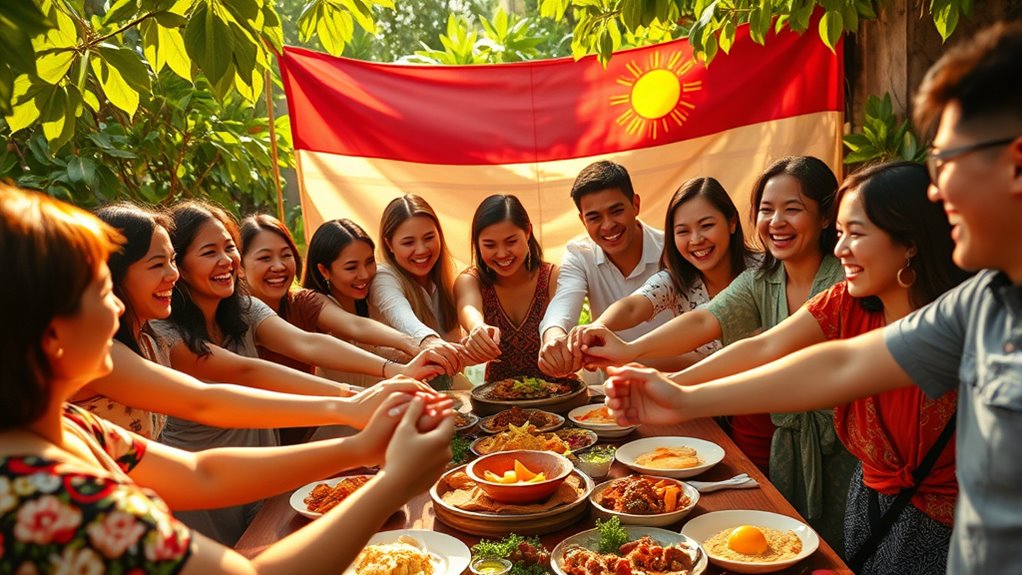
Respect and values form the backbone of Filipino culture, deeply influencing social interactions and community cohesion.
You’ll notice how respect is institutionalized through customs like “mano,” where children greet elders by touching their hands. This practice highlights the importance of hierarchy in families, where elders command authority and respect. The significance of these customs can be seen in the broader context of supernatural beliefs, which often emphasize the reverence for ancestors and the spiritual realm.
By adhering to community norms, you contribute to social harmony, reinforcing shared values. The family unit, considered central to Filipino life, shapes your values through strong bonds and care for the elderly.
These values promote strong relationships and a desire for social acceptance. Humor often diffuses tension, while hospitality and emotional support enhance social interactions, showcasing the depth of respect that defines Filipino culture. Additionally, embracing healthy lifestyle choices contributes to the overall well-being of individuals and communities alike.
Adaptability and Global Connections
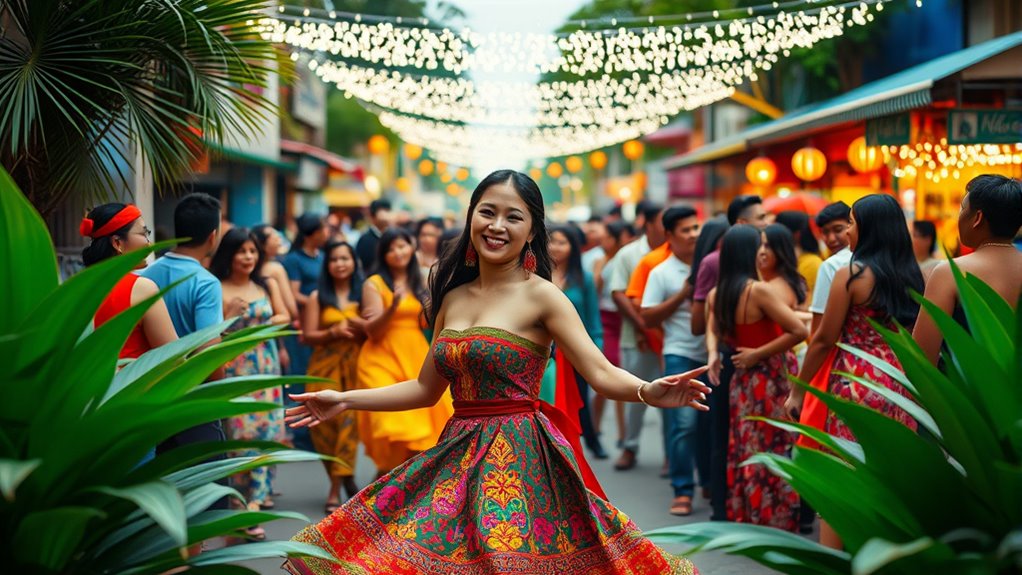
As you explore the richness of Filipino culture, you’ll find that adaptability plays an essential role in shaping global connections.
Filipinos, influenced by diverse cultures, easily adjust to various settings. This adaptability has led to their success in the global workforce, especially in outsourcing and BPOs, where strong English skills shine. Moreover, their ability to emotional regulation in diverse environments fosters better relationships in multicultural workspaces. This secure attachment contributes to the strength of their interpersonal connections, allowing them to build trust and intimacy in various settings. Additionally, their emphasis on mindfulness practices enhances their emotional resilience and interpersonal dynamics. The focus on community support reinforces their commitment to nurturing relationships, creating a strong foundation for family life.
Resilience emerges from this adaptability, helping Filipinos thrive despite challenges while fostering unity in their communities.
As a result, they create welcoming networks worldwide, enhancing cooperation and cultural sensitivity. Their ability to blend into different environments not only opens economic opportunities but also strengthens bonds among diverse groups, making Filipinos valuable contributors in international collaborations and enhancing their global presence. Moreover, their cultural awareness contributes significantly to international career guidance, allowing them to navigate global job markets effectively.
Strengthening Relationships Through Food
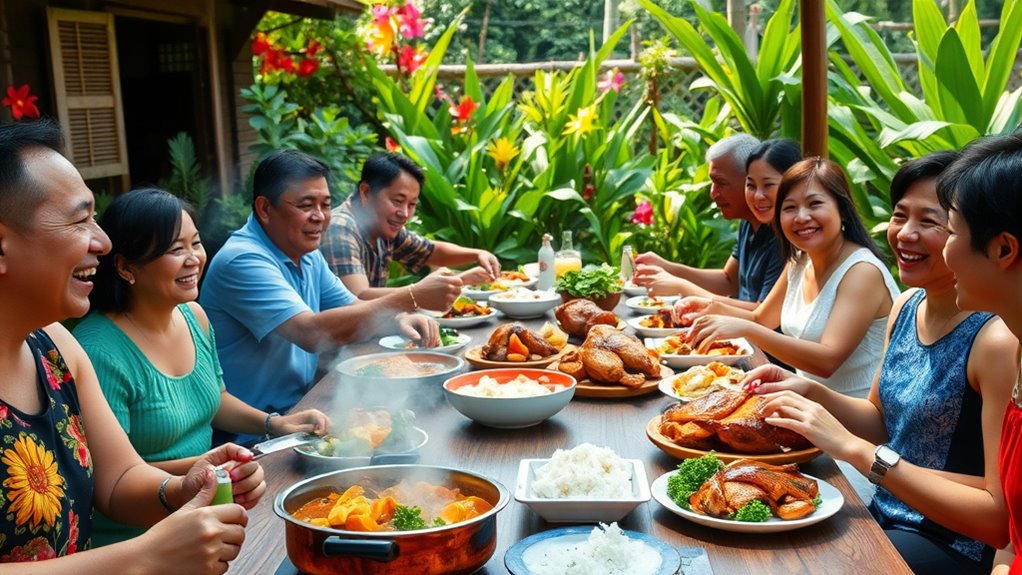
Food serves as a powerful medium for strengthening relationships, creating bonds that transcend cultural boundaries. In Filipino culture, meals often bring people together, fostering a sense of community.
When you gather for a feast, the inclusive atmosphere welcomes newcomers and invites everyone to share in the experience. The aroma of traditional dishes like sinigang evokes fond memories and emotions, making food a conversation starter. Additionally, enjoying meals outdoors during celebrations enhances the joy of connection and mirrors the communal spirit found in practices like kamayan. Engaging in interactive play during meals can also deepen connections as families create shared experiences. Brazilian cuisine also highlights the importance of communal dining through dishes like Rice Carreteiro, which can be enjoyed in a similar spirit of togetherness. Furthermore, the tradition of sharing meals is evident in Braai, where communal grilling brings friends and family closer together.
During family reunions, extensive spreads of beloved recipes reinforce familial ties and cultural continuity. Practices like kamayan, where you eat with your hands, encourage a communal spirit. Ultimately, sharing food nurtures relationships, transforming gatherings into lasting memories filled with love and unity. Culinary delights reminiscent of Southern traditions can further enrich the experience, showcasing the universal language of food.
Cultural Heritage: Stories That Unite Us
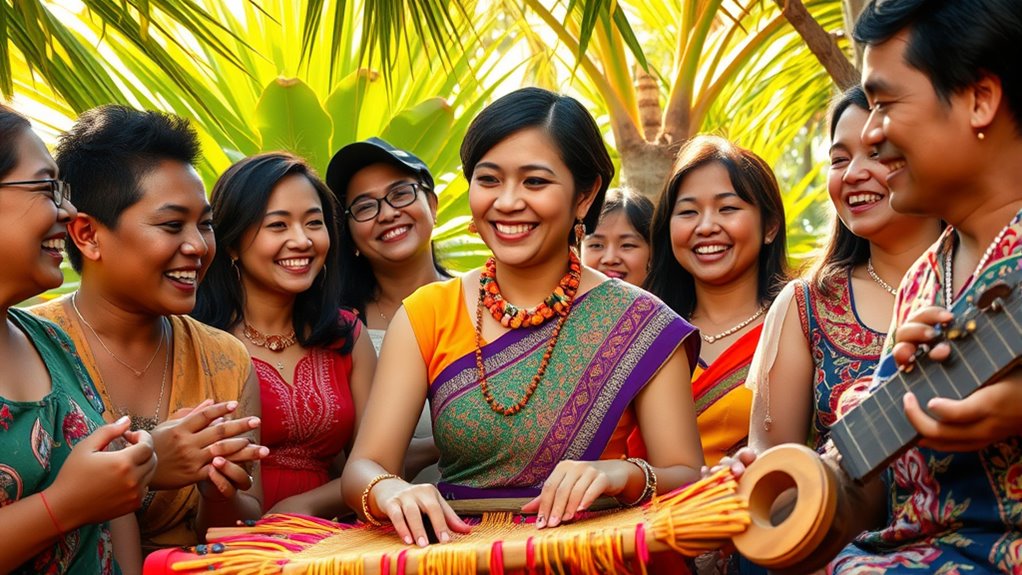
Cultural heritage weaves a rich tapestry of stories that connect us, transcending time and geography. In the Philippines, diverse ethnic groups contribute to this vibrant culture, sharing folk dances like Tinikling and Singkil during celebrations. These dances reflect historical narratives and regional myths, shaping Filipino identity. Additionally, the importance of cross-cultural romance is emphasized through these shared traditions, fostering deeper connections between individuals.
Oral traditions, such as the Darangen epic chant, preserve cultural values and foster community cohesion, much like how Hindi Rider Shayari celebrates the essence of journeys and adventures. Music, featuring traditional instruments like gongs and drums, varies by region, promoting cultural exchange. In the Midwest, historic farmhouses serve as reminders of agricultural heritage and community stories that echo similar themes of connection and history.
Vibrant fiestas unite communities, showcasing shared experiences and local customs. UNESCO recognizes many Filipino practices, highlighting their global significance. Waldorf toys promote imaginative play, encouraging creativity and storytelling, similar to how Filipino traditions inspire connection among generations.
Through educational initiatives and community involvement, we guarantee these stories and traditions endure, uniting us across generations.
Frequently Asked Questions
How Does Filipino Culture Influence Daily Life in the Philippines?
Filipino culture profoundly influences your daily life, shaping everything from family relationships to social interactions.
You value strong family ties, often gathering with extended relatives for meals and celebrations. Respect for elders guides your behavior, while community events foster a sense of belonging.
You embrace hospitality, welcoming friends and strangers alike. The blending of traditions and values creates a vibrant atmosphere, making everyday life rich with connection and meaning.
What Are Common Filipino Values Taught to Children?
Imagine a tapestry woven with vibrant threads of respect, compassion, and community spirit.
In Filipino culture, children learn the importance of family bonds, honoring elders, and supporting one another through life’s ups and downs. They embrace the idea of bayanihan, helping neighbors without expecting anything in return.
Values like gratitude and social harmony fill their hearts, shaping their interactions and guiding them to care for both family and community with unwavering love.
How Do Filipinos Celebrate Weddings and Other Major Life Events?
Filipinos celebrate weddings and major life events with vibrant traditions and communal joy. You’ll witness grand receptions, delicious Filipino dishes, and lively music and dance.
Weddings feature unique elements like the unity veil and the arrhae ceremony, symbolizing commitment and shared prosperity.
Other celebrations, like baptisms and debuts, also involve family gatherings and festive parties, showcasing strong bonds and cultural pride.
These events reflect the community’s love, unity, and shared heritage.
What Role Does Humor Play in Filipino Culture?
Humor in Filipino culture’s like the secret sauce that makes every gathering unforgettable! It eases tension, builds connections, and creates a strong sense of community.
You’ll find humor at family events, helping people bond effortlessly. It’s not just about laughter; it’s a coping mechanism during tough times, reflecting resilience and optimism.
From clever puns to satire, Filipino humor addresses societal issues while celebrating cultural identity, making it an essential part of daily life.
How Does Social Media Impact Filipino Cultural Expression Today?
Social media greatly impacts Filipino cultural expression today.
You’ll notice how platforms like TikTok and Instagram let you showcase your creativity and share local traditions with a global audience. It fosters a sense of pride in your heritage, as humor and viral trends highlight unique aspects of Filipino life.
Plus, these platforms strengthen community bonds, letting you connect with others who share your interests and values, enriching the cultural tapestry you’re part of.
Conclusion
In embracing Filipino culture, you’ve discovered a vibrant community that thrives on connection and shared experiences. Did you know that over 80% of Filipinos consider family as their top priority, showcasing the deep-rooted bonds that unite them? As you celebrate festivals, savor traditional dishes, and appreciate the arts, you strengthen these ties that bring people together. By valuing respect and adaptability, you’ve turned cultural appreciation into lasting relationships, making your journey together all the more meaningful.
